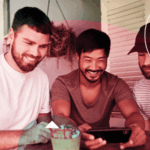By Juliet Howes, Influencer Marketing Director, SAMY
It’s time for a reassessment of influencer marketing. The transaction-based model that has defined the past decade is no longer the only option, and the word ‘influencer’ still conjures an image that betrays how far the market has moved: the archetypal ‘ring light’ creator promising mass reach and broad demographic engagement. That world still exists, though its role is narrowing within a more complex social universe. The reality of influence in 2025 is that investment for many brands is shifting towards authority acquisition.
Brands are no longer simply chasing creators with large audiences and broad or undefined appeal. They are turning instead to people whose sway comes from cultural credibility, professional expertise, or personal authority. In short, the market is maturing. The once-simple influence supply chain has evolved into a nuanced credibility network. For strategic brands seeking meaningful, high-value connection, this evolution is a huge opportunity – and we can already see how companies are leveraging it.
Consider Blacklane, the luxury chauffeur service. When the company wanted to reach senior executives, the obvious choice would have been to target them through other, more traditional marketing channels. Influencer marketing wouldn’t have been part of the conversations. The more “classic” approach would certainly have helped with visibility. But the aim was not just awareness. Blacklane wanted genuine validation within a tightly defined audience. So instead, the business collaborated with people already living in that world: business leaders and high flyers who could use their own platforms to demonstrate how the service supported their professional lives.
These people would never label themselves as ‘influencers’ under the existing model. Yet their ability to shape attitudes was a form of peer-to-peer contextual influence. Their impact came not from having high follower numbers, but from hyper-relevance and proven professional credibility. The result has helped establish Blacklane as the default choice within an exclusive, high-value peer network. That is the difference between a partnership for awareness and a partnership for trust.
Beyond superficial engagement
This dynamic isn’t confined to niche examples. Influence today is layered, stretching across diverse communities and professions. A chef like Sam Way, who built an audience through quick-cut cooking videos, is now deeply associated with UK supermarket Waitrose & Partners. Viewers come for recipes, paying close, focused attention to Sam’s authentic content. Yet the supermarket benefits from a constant, integrated presence within the content. This is the attention dividend within authoritative and credible partnership: the brand secures what it needs without an interruptive ad. There is more of a symbiotic nature to the collaboration.
The same is true of Crocs, which has moved beyond superficial product placements within the influencer market to work with specific DJs and streetwear voices who genuinely embody the energy and creativity of both the brand and its target market. The business is making cultural acquisitions that speak to communities where standing and authority are the currencies that matter.
The same dynamic is even visible in sectors most people would never associate with influencer marketing. Gulf Oil, for example, has tapped creative communities and specialist engineers, from sculptors working with the brand’s unique colours to mechanics producing tutorials on motorbike care. Credibility. Expertise. Authority. The ingredients are the same.
This new focus is also changing where campaigns unfold. LinkedIn, once a niche B2B platform, has become a hub for professional influence. It’s now valuable ground for shaping attitudes within business communities, and brands are learning to navigate it through authentic peer endorsement, while carefully ensuring content feels relevant and useful, not like an advert.
People of influence
The point is not that reach-based creators should be abandoned. Traditional influencers – complete with those ring lights – continue to provide valuable visibility to large audiences. It remains a massive and thriving market. But strategies must reflect the fact that influence now comes from multiple, high-value directions. The most effective campaigns blend these voices to achieve both scale and trust.
For marketing leaders, this demands a rethink of what success looks like. Measurement models that focus solely on clicks and conversions risk missing the larger picture. Influence in 2025 is not a transaction. It is the creation of a cultural asset. It is about being part of conversations that matter to communities, rather than inserting ads into feeds or pausing content for a shoehorned sponsor segment.
The label ‘influencer’ no longer captures this reality. It reduces a diverse ecosystem into a single, superficial category. A better framing is to think in terms of ‘people of influence’. That includes not just the professional content creator, but the executive, the chef, the artist, the engineer, and the DJ whose standing gives a brand genuine legitimacy.




